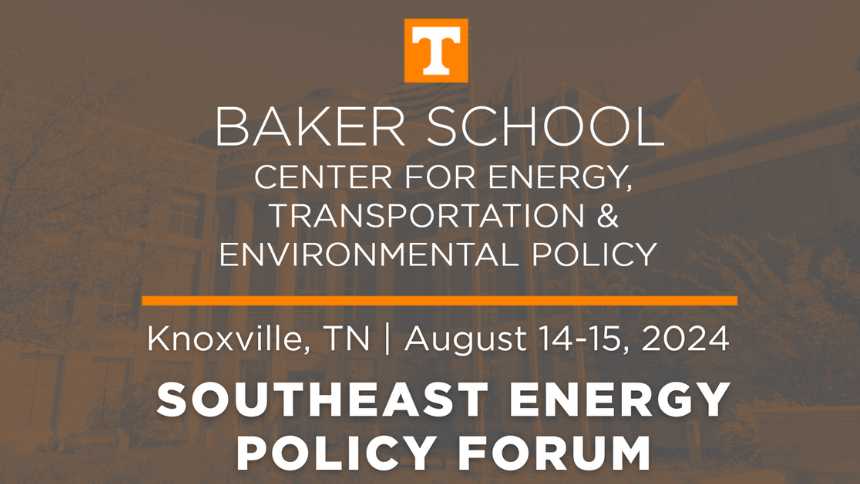
Keynote speakers were just a portion of the “Southeast Energy Policy Forum”
Many of the panelists were from the Volunteer State.
A number of Tennesseans, many from the eastern grand division, spoke during last week’s “Southeast Energy Policy Forum” hosted by and held at the Baker School of Public Policy and Public Affairs at the University of Tennessee, Knoxville. Here are some additional and we thought interesting snippets of information we gleaned over the nearly two-day event.
- David Wade, Chief Executive Officer (CEO) of Chattanooga’s EPB, said the organization’s mission “is to improve the quality of the lives of people in our community.” EPB, formerly known as the Electric Power Board, used American Recovery Act funding to build the nation’s first gigabit network and has now embarked on an even potentially bigger project with its EPB Quantum NetworkSMpowered by Qubitekk.
- Casey Norris, the Federal Program Management Office Lead for the Tennessee Valley Authority (TVA), said her office was created last April after the nation’s largest public utility became eligible for funding under new initiatives like the “Bipartisan Infrastructure Law,” the “Inflation Reduction Act (IRA),” and the “CHIPS and Science Act.” As a result, she said, “We are flying the plane as we are building it,” a reference to the partnerships required to capitalize on the opportunities.
- Molly Cripps, Director of the State of Tennessee’s Office on Energy Programs, cited 70 new programs implemented by the Department of Energy (DOE) including eight or nine that specifically flow through offices such as the one she leads. As an example, Cripps cited a $156 million initiative related to solar energy.
- Paul Smith, TVA’s Director of Fuel Operations, reiterated a frequent statement from the utility’s leadership: power loads or demand across the seven states are growing faster than the national average. Even though TVA has about 45 percent of its power generated by carbon-free sources, “We will be leaning into gas a little more” to meet the increased demand. Smith added that natural gas pipeline capacity is more robust in the western part of Tennessee and more limited in the eastern sections which could become problematic.
- His comments and others from the panel on natural gas pipeline woes caused Moderator Matt Murray, Professor and Baker Center Executive Director Emeritus, to reference the parable that’s often used as a metaphor to illustrate how people and societies can fail to recognize or respond to gradual negative changes in their environment or circumstances. The story goes that if you put a frog in boiling water, it will immediately jump out to save itself. However, if you put the frog in tepid water and gradually heat it up, the frog will not perceive the danger and will be cooked to death. The frog will start adjusting its body temperature to the new environment instead of jumping out, and when it does realize the water is boiling, it will be too late to escape.
- Laura Duncan, TVA Senior Project Manager, and Charles Sims, Director of the Baker School’s Center for Energy, Transportation, and Environmental Policy, tag-teamed on a presentation about TVA’s Valley Pathways study. “We are not predicting the future, we are looking at what is possible,” Duncan said. Sims added that the study actually involves four scenarios: (1) community resiliency; (2) accelerated electrification; (3) low-carbon breakthroughs; and (4) some combination of all three. The team has delivered its preliminary report that will be updated once the Integrated Resource Plan – another TVA study – is finalized.
- Two Knoxville entrepreneurs – Anca Timofte, Co-Founder and CEO of Holocene, a direct carbon capture start-up, and David Morgan, Chief Strategy Officer at Carbon Rivers, which makes “pristine graphene” and also recycles wind turbine blades, explained how their companies are supercharging clean energy technologies.
- And, last but not least, Misty Mayes, CEO of Management Solutions Group, described how her firm, also based in Knoxville, is administering a five-year, $192 million support services contract for DOE’s Office of Clean Energy Demonstrations. “We are derisking it (technology),” Mayes said. “That’s the key thing.” To do so, she says potential grantees must check five boxes: (1) Is it structurally sound? (2) Is it repeatable? (3) Will it benefit the community where it will be located/deployed? (4) Does the grantee have a project management structure to execute? (5) Can it be executed within the time period of the early 2030s?
Like what you've read?
Forward to a friend!

